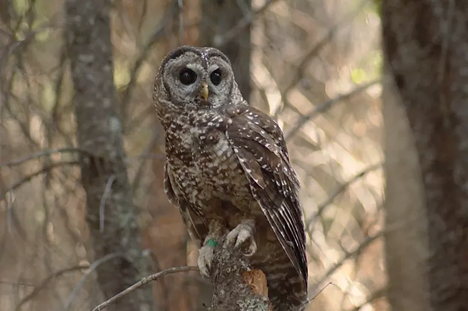Last updated: April 25, 2025
Article
Species Inventories Help Protect Bats and Owls at Devils Postpile National Monument
July 2024
At Devils Postpile National Monument (NM), a species inventory has helped park managers ensure that management actions designed to help preserve threatened bats and owls didn’t end up harming them, instead.

NPS

USFWS/Kuyper
Nature's Contributions
Devils Postpile NM sustains a diverse community of nocturnal animals, including several bat and owl species. Both perform important ecosystem services: bats control insect populations and help reduce mosquito-borne illnesses by consuming up to 100% of their body weight in insects each night, while owls are efficient predators of rodents and other small mammals.Of the 25 bat species present in California, 16 are considered threatened, largely due to habitat loss. The California spotted owl has also experienced alarming declines from habitat loss, justifying its recent listing under the Endangered Species Act.Before the forest-thinning projects proceeded, staff from the National Park Service Inventory and Monitoring Division arranged for an inventory of bat species and the threatened California spotted owl to see if they were present in the park—and, if so, where. They also wanted to compare bat activity in areas with high, medium, and low disturbance from previous fires and trees falling from strong winds. This information would shed light on how disturbance could impact bats in the park, helping park managers better understand how they can support bats when planning fuel treatments.

NPS
Revealing the Results
Acoustic recorders detected 15 bat species, including two sensitive species: pallid bat (Antrozous pallidus) and fringed myotis (Myotis thysanodes). Three species of special concern were also identified: spotted bat (Euderma maculatum), western mastiff bat (Eumops perotis californicus), and western red bat (Lasiurus blossevillii). The study found no strong evidence that bat species richness or activity varied across low-, medium-, and high-disturbance areas. This could be due in part to the study’s small scale. However, the findings align with other research suggesting that moderate disturbance levels may be optimal for bats in Sierra Nevada forests.
To inventory owls, researchers used active call surveys—broadcasting owl vocalizations and documenting any responses. No California spotted owls were detected during the study.
Conserving Habitats
The prescribed fuels thinning and burning would introduce a moderate level of disturbance to the ecosystem. Results from this inventory suggest these management actions would not severely impact bats living in Devils Postpile National Monument. And given the likely minimal or nonexistent presence of California spotted owls in the forest, it is anticipated that the management actions will have negligible effects on these owls.Park staff noted the inventory results “support the goals of the Inyo National Forest fuels treatments and prescribed fire – to generally open the forests to increase resilience to wildfire while retaining large diameter trees for habitat.” With this knowledge, park managers better understand how to conserve habitat for these special night-roaming animals.
Table 1. Bat species identified in this inventory.
|
Common Name |
Scientific Name |
|
Yuma myotis bat |
Myotis yumanensis |
|
Little brown bat |
Myotis lucifugus |
|
Western long-eared bat |
Myotis evotis |
|
California myotis bat* |
Myotis californicus* |
|
Fringed myotis bat* |
Myotis thysanodes* |
|
Western small-footed myotis bat* |
Myotis ciliolabrum* |
|
Long-legged myotis bat |
Myotis volans |
|
Big brown bat |
Eptesicus fuscus |
|
Spotted bat |
Euderma maculatum |
|
Western mastiff bat |
Eumops perotis |
|
Silver-haired bat |
Lasionycteris noctivagans |
|
Hoary bat |
Lasiurus cinereus |
|
Western red bat* |
Lasiurus blossevillii* |
|
Mexican free-tailed bat |
Tadarida brasiliensis |
|
Pallid bat* |
Antrozous pallidus* |
